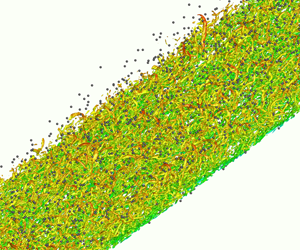Crossref Citations
This article has been cited by the following publications. This list is generated based on data provided by
Crossref.
Sonnenschein, Jana
Friedrich, Pascal
Aghayarzadeh, Moloud
Mierka, Otto
Turek, Stefan
and
Wohlgemuth, Kerstin
2021.
Flow Map for Hydrodynamics and Suspension Behavior in a Continuous Archimedes Tube Crystallizer.
Crystals,
Vol. 11,
Issue. 12,
p.
1466.
Chen, Guo
Wang, Haiou
Luo, Kun
and
Fan, Jianren
2022.
Two-way coupled turbulent particle-laden boundary layer combustion over a flat plate.
Journal of Fluid Mechanics,
Vol. 948,
Issue. ,
Luo, Shibin
Feng, Yanbin
Song, Jiawen
Xu, Dequan
and
Xia, Kunxiong
2022.
Powder fuel transport process and mixing characteristics in cavity-based supersonic combustor with different injection schemes.
Aerospace Science and Technology,
Vol. 128,
Issue. ,
p.
107798.
Wang, Xiangjun
Wan, Minping
and
Biferale, Luca
2022.
Acceleration statistics of tracer and light particles in compressible homogeneous isotropic turbulence.
Journal of Fluid Mechanics,
Vol. 935,
Issue. ,
Zhang, Ping
Li, Wei
Zhang, Teng
Yan, Yingwen
Li, Jinghua
and
Tang, Hao
2023.
Multiscale modeling of liquid jet breakup in crossflow using an Eulerian/Lagrangian approach.
Physics of Fluids,
Vol. 35,
Issue. 12,
Zhao, Kangchun
Xia, Zhixun
Ma, Likun
Duan, Yifan
Zhang, Jiarui
Feng, Yunchao
Cheng, Binbin
and
Yang, Pengnian
2023.
Large-eddy simulation of gas-particle two-phase jet into a supersonic crossflow.
Physics of Fluids,
Vol. 35,
Issue. 2,
Feng, Yanbin
Luo, Shibin
Song, Jiawen
Xia, Kunxiong
and
Xu, Dequan
2023.
Numerical investigation on the combustion characteristics of aluminum powder fuel in a supersonic cavity-based combustor.
Applied Thermal Engineering,
Vol. 221,
Issue. ,
p.
119842.
Gai, Guodong
Thomine, Olivier
Hadjadj, Abdellah
Kudriakov, Sergey
and
Wachs, Anthony
2023.
Preferential Concentration of Particles in Forced Turbulent Flows: Effects of Gravity.
Energies,
Vol. 16,
Issue. 6,
p.
2910.
Li, Tingting
Cui, Zhiwen
Yuan, Xianxu
Zhang, Ying
Zhou, Qiang
and
Zhao, Lihao
2023.
Particle dynamics in compressible turbulent vertical channel flows.
Physics of Fluids,
Vol. 35,
Issue. 8,
Hassanian, R.
Helgadóttir, Á.
Bouhlali, L.
and
Riedel, M.
2023.
An experiment generates a specified mean strained rate turbulent flow: Dynamics of particles.
Physics of Fluids,
Vol. 35,
Issue. 1,
Feng, Yanbin
Luo, Shibin
Song, Jiawen
and
Xu, Dequan
2023.
Numerical investigation on flow and mixing characteristics of powder fuel under strong shear and shock wave interaction.
Energy,
Vol. 263,
Issue. ,
p.
126061.
Ding, Hongming
Zhuo, Changfei
Deng, Hanyu
Hu, Wenjun
and
Chen, Xiong
2023.
Numerical study on coupled flow characteristics of a gas-solid two-phase jet in a supersonic crossflow.
International Journal of Multiphase Flow,
Vol. 168,
Issue. ,
p.
104583.
Feng, Yanbin
Luo, Shibin
Song, Jiawen
and
Xu, Dequan
2023.
Numerical investigation on the combustion characteristics of powder fuel under different regulation parameters.
Aerospace Science and Technology,
Vol. 142,
Issue. ,
p.
108608.
Hassanian, Reza
and
Riedel, Morris
2023.
Leading-Edge Erosion and Floating Particles: Stagnation Point Simulation in Particle-Laden Turbulent Flow via Lagrangian Particle Tracking.
Machines,
Vol. 11,
Issue. 5,
p.
566.
Abbasi, S.
and
Mehdizadeh, A.
2024.
A computational study on the effect of particle characteristics on the deposition of small particles in turbulent wall-bounded flows.
International Journal of Multiphase Flow,
Vol. 174,
Issue. ,
p.
104754.
Tukmakov, D. A.
2024.
Numerical Study of the Influence of Boundary Conditions on Calculations of the Dynamics of Polydisperse Gas Suspension.
Prikladnaâ matematika i mehanika,
Vol. 88,
Issue. 3,
p.
422.
Patel, Meet
Rubio, Juan Sebastian
Shekhtman, David
Parziale, Nick
Rabinovitch, Jason
Ni, Rui
and
Capecelatro, Jesse
2024.
Experimental and numerical investigation of inertial particles in underexpanded jets.
Journal of Fluid Mechanics,
Vol. 1000,
Issue. ,
Li, Junjie
Han, Suofeng
Han, Wenxue
Wei, Ronggang
Hu, Chunbo
and
Li, Chao
2024.
Numerical simulation study on the interaction between hydrogen flame and particle flame in scramjet.
Physical Review Fluids,
Vol. 9,
Issue. 6,
Liao, Zi-Mo
Chen, Liang-Bing
Wan, Zhen-Hua
Liu, Nan-Sheng
and
Lu, Xi-Yun
2024.
GPU acceleration of four-way coupled PP-DNS for compressible particle-laden wall turbulence.
International Journal of Multiphase Flow,
Vol. 176,
Issue. ,
p.
104840.
Ma, Likun
Xu, Luxi
Zhao, Kangchun
Yang, Pengnian
Feng, Yunchao
Chen, Binbin
and
Xia, Zhixun
2024.
Preferential concentration in supersonic gas-particle two-phase transverse jets.
Particuology,
Vol. 94,
Issue. ,
p.
29.



